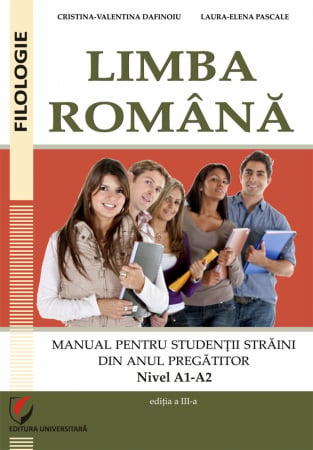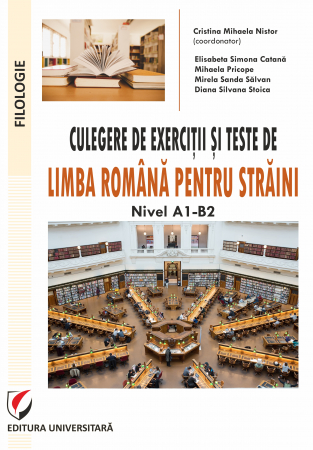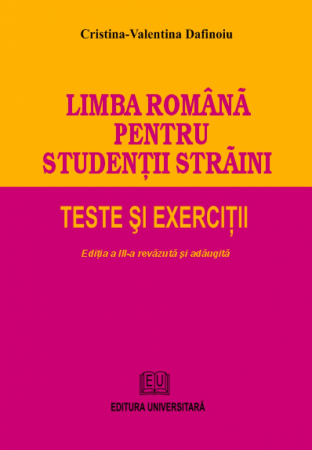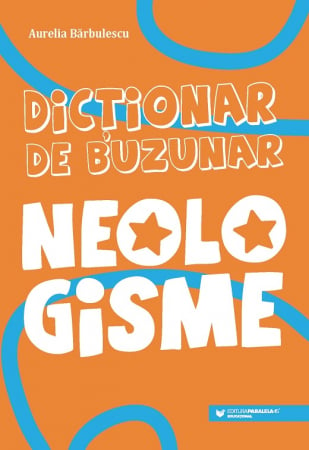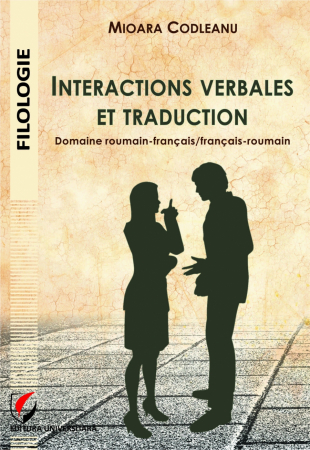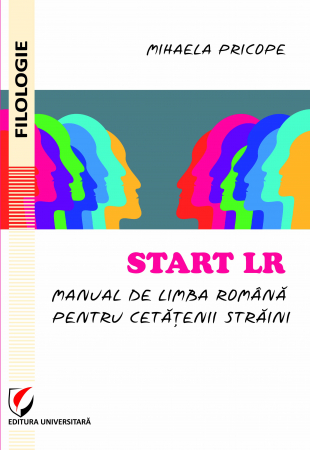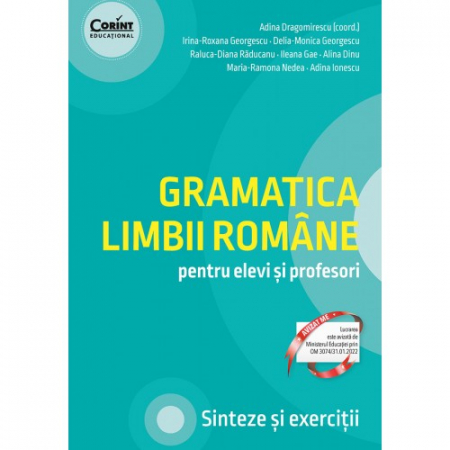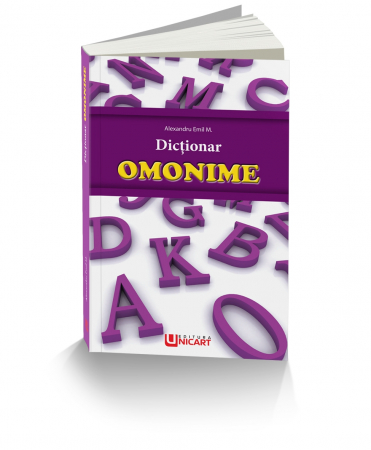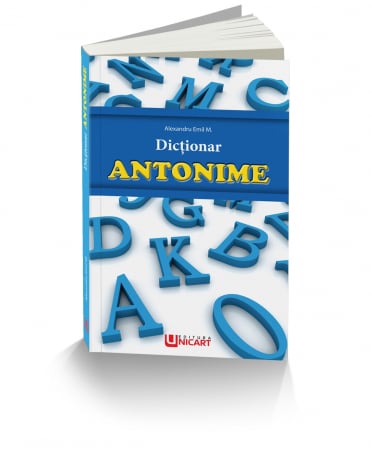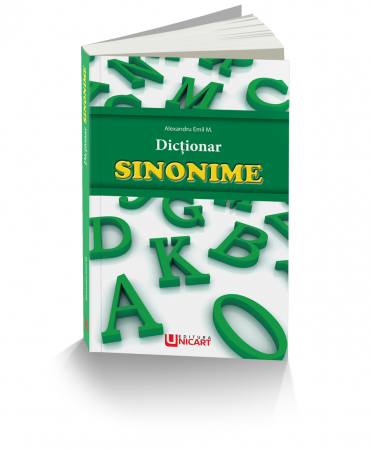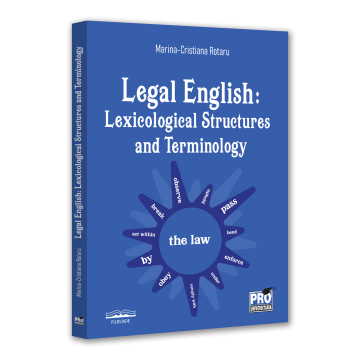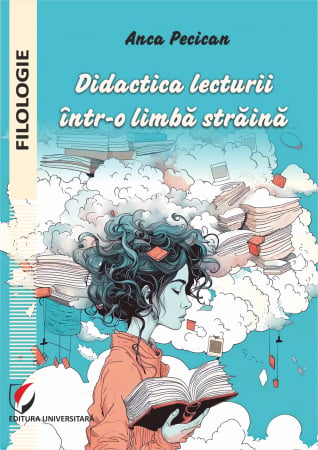COMENZILE PRIMITE ÎN PERIOADA 19.12.2025 - 07.01.2026 VOR FI ONORATE ÎNCEPÂND CU 08.01.2026
Editura: Editura Universitară
Autor: Nicoleta Adina Panait
Ediția: I
Pagini: 162
Anul publicării: 2024
ISBN: 978-606-28-1646-9
DOI: https://doi.org/10.5682/9786062816469
Cod Produs:
9786062816469
Ai nevoie de ajutor?
0745 200 357
- Descriere
- Download (1)
- Autori
- Cuprins
- Cuvânt înainte
- Review-uri (0)
"This research represents a valuable contribution to the study of applied linguistics through the interdisciplinary approach employed. The author's work reflects profound expertise, exceptional analytical and synthetic skills, and the attributes of a meticulous researcher. A thorough examination of the work prompts us to highlight the original and nuanced approaches. The aspects outlined in the book are intelligently articulated and persuasively argued, complemented by intriguing solutions."
Professor Mihai Zdrenghea "Babes-Bolyai" University, Cluj-Napoca
Professor Mihai Zdrenghea "Babes-Bolyai" University, Cluj-Napoca
-
Genre-related dimensions in academic writing at master level - Nicoleta-Adina Panait
Descarcă
NICOLETA-ADINA PANAIT has obtained her PhD in English Philology with Magna Cum-Laude from "Babes-Bolyai" University in Cluj-Napoca and unfolds fer academic activity at the Bucharest University of economic Studies. Her research interests include ESL learners' development of ESP and EAp communication competences, as well as the academics' professional development in Higher Education, with a focus on genre analysis, EMI Programmers, Legal English and Romanian as a foreign language.
ACKNOWLEDGEMENTS / 7
PREFACE / 9
CHAPTER 1. INTRODUCTION / 13
Initial considerations / 13
Argument for analyzing genre related dimensions in master dissertations / 13
Setting the scene / 14
Overall purpose / 15
Research questions / 16
Assumptions, starting hypothesis / 16
CHAPTER 2. THEORETICAL FRAMEWORK / 18
Literature Review / 18
Dissertations in English for Specific Purposes / 23
Students as researchers / 24
Methodological Considerations / 25
Genre analysis and corpus based analysis / 25
Research needs / 28
Corpus Analysis / 29
Latest studies in the field / 31
CHAPTER 3. CORPUS DESCRIPTION / 33
Romanian Case Study / 33
Composition and compilation of the READ Corpus / 33
A Corpus Based Approach / 36
CHAPTER 4. FINDINGS AND DISCUSSION / 38
IMRD Introduction–Methods–Results–Discussion / 38
Academic Literacies Perspective on Second Language / 40
An ethnography of writing / 40
Writing Assessment – CEFR, Core Inventory, ELP Checklists / 42
Aspects to look at and to look for in dissertations / 42
Macro Level Analysis / 44
Analysis for Findings and Discussion section and Conclusion section / 47
Topical decomposition – CARS Mode / 47
Relevance of the current sub-section / 47
Initial Findings / 50
Titles, Headings and Subheadings / 52
Preliminary Conclusion / 55
Preferred Combinations & Sequencing / 56
Examples of interconnections and sequencing of moves and steps / 56
Presence of Moves in the READ Corpus / 59
Micro Level Analysis / 64
Assessment Tools & Wordlists / 64
A Case in Point – Small scale analysis of corpus / 68
Language Functions in Academic Writing / Master Dissertations / 69
Lexis and Grammar levels B2 and C1 / 69
Identity: the use of I versus we / 73
Elements of Novelty / 78
Hedging / 78
Range of linguistic meams / hedging / 79
Modality / 80
Can & Could / 81
Accuracy, Coherence and Cohesion / 82
Coherence / 82
Cohesion / 82
Experience has taught us all about the ways to ensure coherent Academic Writing / 83
Developing Coherent Academic Writing / 84
Conclusion / 87
Attaining Cohesive Academic Writing / 88
Conclusion / 89
Tenses / 93
Triangulation – Giving a voice to Teachers and Alumni / 96
Teacher Questionnaires / 97
Questionnaires for Graduate Students / Programme alumni / 100
CHAPTER 5. CONCLUSIONS AND IMPLICATIONS / 104
List of Appendices, Tables and Figures / 107
Glossary of Abbreviations / 109
Bibliography / 110
Appendices / 122
PREFACE / 9
CHAPTER 1. INTRODUCTION / 13
Initial considerations / 13
Argument for analyzing genre related dimensions in master dissertations / 13
Setting the scene / 14
Overall purpose / 15
Research questions / 16
Assumptions, starting hypothesis / 16
CHAPTER 2. THEORETICAL FRAMEWORK / 18
Literature Review / 18
Dissertations in English for Specific Purposes / 23
Students as researchers / 24
Methodological Considerations / 25
Genre analysis and corpus based analysis / 25
Research needs / 28
Corpus Analysis / 29
Latest studies in the field / 31
CHAPTER 3. CORPUS DESCRIPTION / 33
Romanian Case Study / 33
Composition and compilation of the READ Corpus / 33
A Corpus Based Approach / 36
CHAPTER 4. FINDINGS AND DISCUSSION / 38
IMRD Introduction–Methods–Results–Discussion / 38
Academic Literacies Perspective on Second Language / 40
An ethnography of writing / 40
Writing Assessment – CEFR, Core Inventory, ELP Checklists / 42
Aspects to look at and to look for in dissertations / 42
Macro Level Analysis / 44
Analysis for Findings and Discussion section and Conclusion section / 47
Topical decomposition – CARS Mode / 47
Relevance of the current sub-section / 47
Initial Findings / 50
Titles, Headings and Subheadings / 52
Preliminary Conclusion / 55
Preferred Combinations & Sequencing / 56
Examples of interconnections and sequencing of moves and steps / 56
Presence of Moves in the READ Corpus / 59
Micro Level Analysis / 64
Assessment Tools & Wordlists / 64
A Case in Point – Small scale analysis of corpus / 68
Language Functions in Academic Writing / Master Dissertations / 69
Lexis and Grammar levels B2 and C1 / 69
Identity: the use of I versus we / 73
Elements of Novelty / 78
Hedging / 78
Range of linguistic meams / hedging / 79
Modality / 80
Can & Could / 81
Accuracy, Coherence and Cohesion / 82
Coherence / 82
Cohesion / 82
Experience has taught us all about the ways to ensure coherent Academic Writing / 83
Developing Coherent Academic Writing / 84
Conclusion / 87
Attaining Cohesive Academic Writing / 88
Conclusion / 89
Tenses / 93
Triangulation – Giving a voice to Teachers and Alumni / 96
Teacher Questionnaires / 97
Questionnaires for Graduate Students / Programme alumni / 100
CHAPTER 5. CONCLUSIONS AND IMPLICATIONS / 104
List of Appendices, Tables and Figures / 107
Glossary of Abbreviations / 109
Bibliography / 110
Appendices / 122
This book proposed by Nicoleta Adina Panait is based on her PhD research, concluded in 2018 and it represents a valuable contribution to the study of applied linguistics in an interdisciplinary approach. In the execution of this complex study, Nicoleta Adina Panait demonstrates thorough research skills, based on a solid linguistic background, coupled with an interest in exploring the various facets of state of the art linguistic analysis methods.
This book results from the author’s pursuit to bring a valuable contribution to the field of applied linguistics in an interdisciplinary approach. The analysis of written communication in English focuses on the specific genre features encountered in master's dissertations within the dynamics of linguistic competence development in a non-Anglophone country. The study captures what could be considered state-of-the-art in a given academic context in the time span covered by the research, while also pointing to evolving processes in dissertation writing: the continuous refining of generic features, methodological complexity a.s.o. In the context of university internationalization objectives in general, and the increasing concerns within the Romanian academic environment to enhance the linguistic skills of university teaching staff, this work examines these complex linguistic realities from multiple perspectives: at the macro level of organizing the text in a corpus of master's dissertations, as well as at the micro level of linguistic details, by comparing them to the descriptions of language proficiency levels in the Common European Framework of Reference for Languages (Council of Europe, 2001). Genre analysis is complemented by integrating the perspectives of professors and graduates of the master's programme, which constitutes the case study, to explore possible correlations between the level of linguistic competence acquired by programme participants (as reflected in the analyzed texts) and its potential impact on educational activities, especially when conducted in English.
Following a brief introductory chapter, which includes the rationale for this topic and an overview of the thesis structure and sources used, Chapter 2 ("Theoretical Perspective") outlines the conceptual and theoretical framework of the research, with relevant methodological comparisons and delimitations, highlighting the latest trends in the field of genre analysis in non Anglophone academic environments and corpus based analysis.
Chapter 3 ("Corpus Description") brings to the forefront the case study in Romania based on a corpus of 25 representative dissertations, written in English, within an interdisciplinary master's programme designed for university teaching staff in the Romanian academic context. This chapter describes both the composition of the READ corpus (Romanian English Academic Discourse) and the steps taken in this corpus based analysis using specialized software (AntConc).
Chapter 4 ("Results and Discussions") is the most extensive and consists of multiple sub chapters, further subdivided into sub sub chapters. The main sub chapters include "IMRD - Introduction - Method - Results - Discussion" (following the literature in Anglophone linguistics applied to the analysis of dissertations and research articles), "Macro level Analysis," "Micro level Analysis," and "Triangulation The Voice of Professors and Graduates." The textual analysis focuses on the Discussion and Conclusion sections of the dissertations to identify the specific features of the analyzed corpus in comparison to the established features in the Anglophone academic environment, as detailed in the genre analysis and corpus based analysis literature. The merit of this applied linguistics book lies not only in its focus on master's dissertations written in English in the Romanian academic context but also in its comprehensive methodological approach, which combines genre analysis with the analysis of a rigorously constructed corpus using corpus linguistics techniques. Furthermore, the author integrates the evaluation of linguistic features identified at the micro level by comparing them to the internationally recognized and widely accepted language proficiency level descriptors, as developed by the Council of Europe and further detailed by experts from the British Council and the EAQUALS international association. Academic discourse analyses are present in the literature of other non Anglophone countries, especially when comparing native English-speaking researchers’ language with that of native speakers of other languages (e.g. Spanish, Italian, Polish, Czech, etc.), but in these studies, there is no comparison with level descriptors developed at European level. Therefore, this book can be considered groundbreaking in opening new research perspectives, not only within Romanian applied linguistics, but also in a broader European context.
An additional merit lies in the "triangulation" through the qualitative analysis of opinions expressed by professors involved in coordinating and conducting the master's programme, as well as by programme graduates, who reflect on the impact of the programme on their own educational and research activities. Integrating the perspective of professors teaching in the Master's program is a valuable contribution of this research, as it allows the author to compare her own research findings with the views expressed by the professors, who, based on the identification of the development needs of programme participants, have introduced new courses and/or adapted existing ones in order to more effectively facilitate the development of academically relevant communication skills. Indirectly, these new curriculum developments confirm the assessment undertaken by the author in her applied linguistics research conducted on the texts of master's dissertations. In this 360 degree evaluative approach, the circle is closed by integrating the perspective of programme graduates, who refer to the skills, experience, and inspiration gained through the programme, allowing them to approach their own educational and research activities in a new way.
The work draws to a close with a chapter of conclusions and implications, followed by appendices, tables, and images, a glossary of terms and abbreviations used in the work, an extensive, diverse, up to date bibliography, and a substantial set of appendices that illustrate the research process incorporated into this book. This complex study allows the author to reach highly relevant conclusions for both the specific applied linguistics field of genre analysis and corpus based research in our country and for the deepening of the relationship between linguistics and the educational dimension. The author’s work also illustrates the multiple dimensions of methodological complementarity, allowing her to explore new, less researched areas that are all the more valuable for their potential.
From the reading of the entire work, the rigour of the scientific approach in addressing a highly relevant subject emerges, as well as the originality of the book. At its core lies thorough research, reflected in extensive, harmoniously integrated bibliographic references and in the applied part. Therefore, considering the timeliness of the topic and the analysis methods used, the work deserves to be published so that a wider audience can access it.
Laura Mihaela Mureșan
Bucharest University of Economic Studies
This book results from the author’s pursuit to bring a valuable contribution to the field of applied linguistics in an interdisciplinary approach. The analysis of written communication in English focuses on the specific genre features encountered in master's dissertations within the dynamics of linguistic competence development in a non-Anglophone country. The study captures what could be considered state-of-the-art in a given academic context in the time span covered by the research, while also pointing to evolving processes in dissertation writing: the continuous refining of generic features, methodological complexity a.s.o. In the context of university internationalization objectives in general, and the increasing concerns within the Romanian academic environment to enhance the linguistic skills of university teaching staff, this work examines these complex linguistic realities from multiple perspectives: at the macro level of organizing the text in a corpus of master's dissertations, as well as at the micro level of linguistic details, by comparing them to the descriptions of language proficiency levels in the Common European Framework of Reference for Languages (Council of Europe, 2001). Genre analysis is complemented by integrating the perspectives of professors and graduates of the master's programme, which constitutes the case study, to explore possible correlations between the level of linguistic competence acquired by programme participants (as reflected in the analyzed texts) and its potential impact on educational activities, especially when conducted in English.
Following a brief introductory chapter, which includes the rationale for this topic and an overview of the thesis structure and sources used, Chapter 2 ("Theoretical Perspective") outlines the conceptual and theoretical framework of the research, with relevant methodological comparisons and delimitations, highlighting the latest trends in the field of genre analysis in non Anglophone academic environments and corpus based analysis.
Chapter 3 ("Corpus Description") brings to the forefront the case study in Romania based on a corpus of 25 representative dissertations, written in English, within an interdisciplinary master's programme designed for university teaching staff in the Romanian academic context. This chapter describes both the composition of the READ corpus (Romanian English Academic Discourse) and the steps taken in this corpus based analysis using specialized software (AntConc).
Chapter 4 ("Results and Discussions") is the most extensive and consists of multiple sub chapters, further subdivided into sub sub chapters. The main sub chapters include "IMRD - Introduction - Method - Results - Discussion" (following the literature in Anglophone linguistics applied to the analysis of dissertations and research articles), "Macro level Analysis," "Micro level Analysis," and "Triangulation The Voice of Professors and Graduates." The textual analysis focuses on the Discussion and Conclusion sections of the dissertations to identify the specific features of the analyzed corpus in comparison to the established features in the Anglophone academic environment, as detailed in the genre analysis and corpus based analysis literature. The merit of this applied linguistics book lies not only in its focus on master's dissertations written in English in the Romanian academic context but also in its comprehensive methodological approach, which combines genre analysis with the analysis of a rigorously constructed corpus using corpus linguistics techniques. Furthermore, the author integrates the evaluation of linguistic features identified at the micro level by comparing them to the internationally recognized and widely accepted language proficiency level descriptors, as developed by the Council of Europe and further detailed by experts from the British Council and the EAQUALS international association. Academic discourse analyses are present in the literature of other non Anglophone countries, especially when comparing native English-speaking researchers’ language with that of native speakers of other languages (e.g. Spanish, Italian, Polish, Czech, etc.), but in these studies, there is no comparison with level descriptors developed at European level. Therefore, this book can be considered groundbreaking in opening new research perspectives, not only within Romanian applied linguistics, but also in a broader European context.
An additional merit lies in the "triangulation" through the qualitative analysis of opinions expressed by professors involved in coordinating and conducting the master's programme, as well as by programme graduates, who reflect on the impact of the programme on their own educational and research activities. Integrating the perspective of professors teaching in the Master's program is a valuable contribution of this research, as it allows the author to compare her own research findings with the views expressed by the professors, who, based on the identification of the development needs of programme participants, have introduced new courses and/or adapted existing ones in order to more effectively facilitate the development of academically relevant communication skills. Indirectly, these new curriculum developments confirm the assessment undertaken by the author in her applied linguistics research conducted on the texts of master's dissertations. In this 360 degree evaluative approach, the circle is closed by integrating the perspective of programme graduates, who refer to the skills, experience, and inspiration gained through the programme, allowing them to approach their own educational and research activities in a new way.
The work draws to a close with a chapter of conclusions and implications, followed by appendices, tables, and images, a glossary of terms and abbreviations used in the work, an extensive, diverse, up to date bibliography, and a substantial set of appendices that illustrate the research process incorporated into this book. This complex study allows the author to reach highly relevant conclusions for both the specific applied linguistics field of genre analysis and corpus based research in our country and for the deepening of the relationship between linguistics and the educational dimension. The author’s work also illustrates the multiple dimensions of methodological complementarity, allowing her to explore new, less researched areas that are all the more valuable for their potential.
From the reading of the entire work, the rigour of the scientific approach in addressing a highly relevant subject emerges, as well as the originality of the book. At its core lies thorough research, reflected in extensive, harmoniously integrated bibliographic references and in the applied part. Therefore, considering the timeliness of the topic and the analysis methods used, the work deserves to be published so that a wider audience can access it.
Laura Mihaela Mureșan
Bucharest University of Economic Studies
Dacă dorești să iți exprimi părerea despre acest produs poți adăuga un review.
Scrie un review

6359.png)
![Genre-related dimensions in academic writing at master level - Nicoleta-Adina Panait [1] Genre-related dimensions in academic writing at master level - Nicoleta-Adina Panait [1]](https://gomagcdn.ro/domains/editurauniversitara.ro/files/product/large/genre-related-dimensions-in-academic-writing-at-master-level-299119.jpg)
